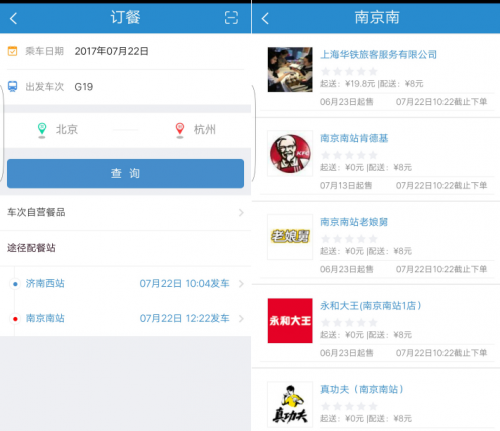Starting last week, specifically on July 17th, 27 high-speed railway passenger stations across the country launched the EMU internet meal-ordering service. From then on, high-speed rail truly entered the era of take-out. For trains classified as high-speed or bullet trains—those prefixed with G and D—you can now place orders via the 12306 website or the mobile app. Besides meals provided by train vendors, well-known social brands in the food and beverage industry are also getting involved.
In fact, high-speed rail dining has long been a topic of controversy in recent years. Despite numerous media reports detailing the reasons behind high prices and the monopoly-like status of train food services, consumers have consistently expressed dissatisfaction with these limited options. They yearn for more diverse choices. The introduction of this new take-out service addresses both the issue of passenger dining and opens the door to market competition for onboard meals.
But can these meal reservations be trusted to work smoothly? Will passengers actually receive their food on time? With these questions in mind, I decided to personally test out the high-speed rail take-out service.
To my surprise, booking through the app turned out to be surprisingly straightforward. The ultimate aim of online ordering is to cater to all passengers, not just tech-savvy younger users. If the process were overly complex, it wouldn't be practical. So, how user-friendly is it to book via an app or the internet? Opening either the app or web client, you’ll easily find the relevant page in a more prominent location. This shows that significant effort has been made from the outset to ensure that this online ordering feature becomes a standard service, not just a superficial addition.
In short, the overall experience is fairly intuitive, especially for those familiar with mobile ordering or app operations. The process can essentially be summed up as selecting your trip, choosing the station, picking a food brand, filling out the order details, making the payment, and waiting for your meal.
Once you’ve chosen your travel date, the system will display the available delivery stations. According to official information, not all high-speed rail stations currently support take-out delivery. Only cities like Shanghai, Tianjin, Guangzhou, Nanjing, Hangzhou, Xi’an, Shenyang, Changchun, Wuhan, and Jinan were included in the first batch of 27 stations. Unfortunately, Beijing South Railway Station wasn’t among them. Perhaps this is because it primarily serves as a starting station for many trains or due to insufficient preparation. I’m confident that more stations will be added soon.
Both Jinan West and Nanjing South on the Beijing-Hangzhou high-speed line support meal delivery, and the times align with typical lunch hours. Based on my experience, I’d like to remind everyone that deliveries at high-speed rail stations usually arrive at your seat after the train has stopped. There’s still a window of time before your meal arrives, and delays are not uncommon (though less likely on high-speed trains). Therefore, I recommend that passengers with specific dining needs opt for earlier stops to avoid waiting too long and risking hunger.

Overall, the high-speed rail take-out service has great potential, though there are still some logistical challenges to overcome. It’s a step forward in enhancing passenger convenience and introducing competitive market forces to what was once a monopolized sector.
Kinetic Energy Materials,Friction Kinetic Energy,Gravitational Kinetic Energy,Materials That Absorb Kinetic Energy
Shaanxi Xinlong Metal Electro-mechanical Co., Ltd. , https://www.cnxlalloys.com